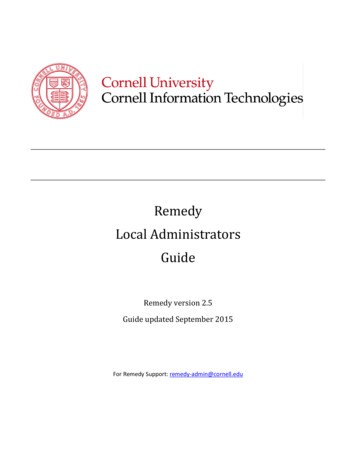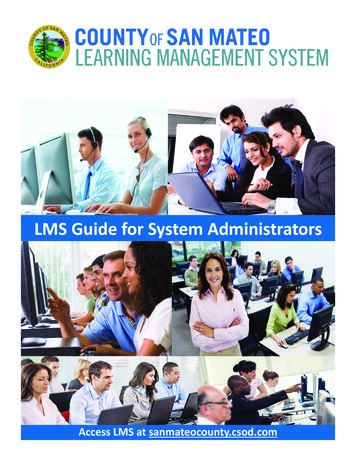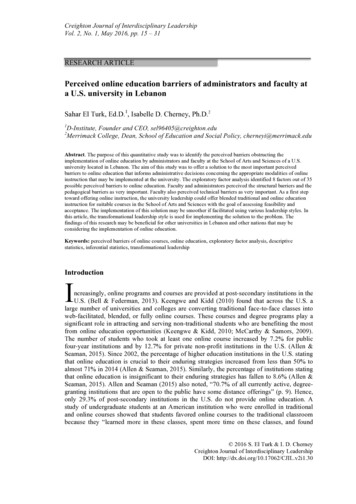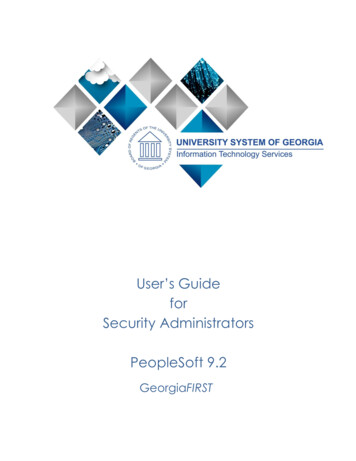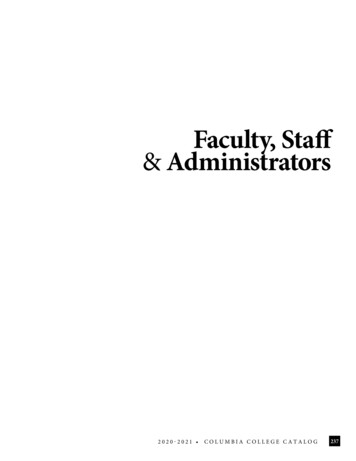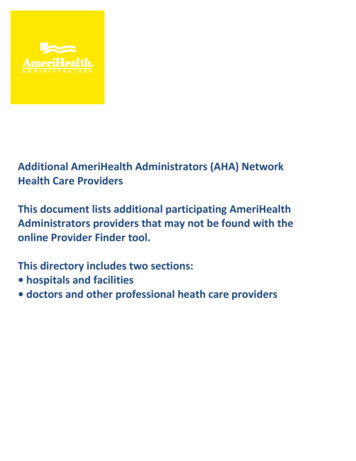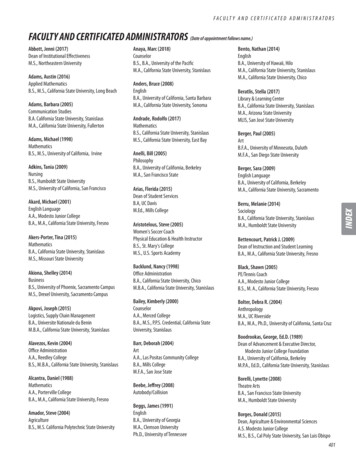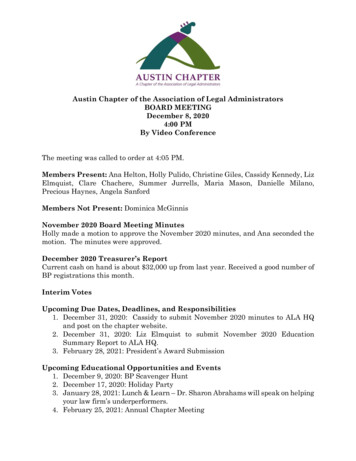
Transcription
ADMINISTRATORS’ QUICK GUIDE TOIMPROVINGSCHOOLCULTURENOWSPONSORED BY:
Administrators’ Quick GuideDear Educators,School culture may be hard to define,but one thing is certain: You knowwhat positive school culture iswhen you see it and when you feel it.When a student, a parent, a new teacheror a district administrator walks into anyschool for the first time, he or she knowsimmediately whether or not this is a placehe or she wants to be. How does your schoolenvironment feel to a newcomer? Hostileor welcoming? Worn out or energetic?Despairing or hopeful?A school’s culture is determined by thevalues, shared beliefs and day-in, day-outbehavior of the entire community—students,teachers, families and staff. It is the countless small moments in the classroom, theimportant traditions and the invisible rules,the praise, the discipline and the expectations for good or for bad that make up theexperience of being in your school.If your school culture is not what youwant it to be, the time to commit to changeis now. With determination and a full teameffort, your school can be the kind of placethat makes visitors smile as soon as theywalk in the door.This guide to Building Positive SchoolCulture, sponsored by Boys Town anddesigned especially for school leaders, willshow you the first steps your staff can take.To download additional copies, TS38 waysto buildpositiveschoolculturenow5Break theconflictcycle atschool75 approachesto buildingpositiverelationshipswith parents8How oneChicagoschoolbecame ahaven fromviolenceweareteachers.com/positivecultureguide
Administrators’ Quick Guide8 WAYS TO BUILD POSITIVESCHOOL CULTURE NOWLife is all about relationships. So is school.Building a positiveenvironment in individualclassrooms and throughoutyour whole school takescommitment and consistencyfrom the whole team—youradministrators, teachers andsupport staff. But you can makeit happen, even in challengingschool environments.Here are eight guidelinesfor improving your school culture based on the Boys Towneducational model, which hashelped hundreds of troubledschools turn their culturearound.Strong1 BuildRelationshipsYour success at creating awell-managed school dependsmore than anything else on thequality of the relationships thatteachers forge with students.3“A strong set of school rules tells yourstudents ‘We know you can achieve. This isthe positive environment you deserve.’”Staff–student relationshipsinfluence everything—from thesocial climate to the individualperformances of your students.The research on this is clear.When students feel liked andrespected by their teachers,they find more success inschool, both academically andbehaviorally (Lewis, Schaps,Watson, 1996). Conversely,when interpersonal relationships are weak and trust is lacking, fear and failure will likelystart to define school culture.Building strong relationshipsneeds to be a schoolwide priority. How do you do it? Teachersneed to have time to talk totheir students in and out of theclassroom. The goal should befor every adult in the buildingto maintain a high rate of positive interactions with studentsand to show genuine interest intheir lives, their activities, theirgoals and their struggles.Essential2 TeachSocial SkillsHow to share, how to listen toothers, how to disagree respectfully—these are the kinds ofessential social skills we expectour students to have. But thetruth is they may not havelearned them. Whether it’s firstgrade or 11th grade, we need tobe prepared to teach appropriate social-emotional behaviors.“You can’t hold kids accountable for something you’ve nevertold them,” says Erin Green,Director of National Training atBoys Town. “Behavior shouldbe treated like academics, andstudents should be taught theskills they need to executedesired behaviors.” Thesebehaviors and values includehonesty, sensitivity, concernand respect for others, a senseof humor, reliability, and more.Together as a staff, you shouldidentify the social skills youwant your students to have andthe step-by-step routines toteach them.on the3 GetSame PageEvery classroom environmentcontributes to your schoolweareteachers.com/positivecultureguide
Administrators’ Quick Guide8 WAYS TO BUILD POSITIVE SCHOOL CULTURE NOWculture. Sometimes, for realchange to occur with students, it’s the adults who haveto change first. Together asa staff, you need to create ashared vision of your school.That means developing consistent school rules and waysof defining and meeting student behavior. When studentsbelieve that the rules are fairand consistently enforced, itgoes a long way toward building trust. Inappropriate behavior shouldn’t be laughed off inone classroom and punished inanother.Classroom4 Clarifyand School RulesClassroom rules communicateyour expectations to your students. They tell students, “thisis the positive environment youdeserve. This is the standardof behavior we know you canachieve.”Positive rules help create apredictable, stable environment that is more conducive tohealthy interactions. Ideally,classroom rules are simple anddeclarative (e.g., “Be respectfuland kind.”). They don’t need toaddress every possible problem.You don’t need a rule aboutgum chewing or water bottleuse, for instance—your policieson these issues should be clearfrom your overarching expectations for good behavior. Mostimportant, rules need to beconsistent across the building.The same expectations need toapply in the classroom, the gymand the cafeteria equally.All Students5 TeachProblem SolvingProblems will always come upinside and outside of school.Students are much more likely to recognize and resolvethem appropriately whenwe teach them how to do so.Problem solving can also beused retrospectively (with theluxury of hindsight) to helpstudents make better decisionsin the future. The Boys TownEducation Model uses theSODAS method to teach stu4dents the general skills of problem solving.SODAS is an acronym for thefollowing steps:S - Define the SITUATION.O - Examine OPTIONS availableto deal with the problem.D - Determine theDISADVANTAGES of eachoption.A - Determine theADVANTAGES of each option.S – Decide on a SOLUTION andpractice.6 Be Role ModelsAt school, students learn asmuch by watching as by doing.Observing the actions of othersAppropriate7 SetConsequencesEstablishing classroom andschoolwide rules and procedures is one of the mostimportant step in any effort tobring more structure to yourschool. But of course, students will push the limits andyou’ll still need consequences.Effective consequences arenot simply punishments andnever delivered in anger. Theyshow young people the connection between what they doand what happens as a resultof their choices or actions.Consequences need to beappropriate, immediate andstudent might write a letter ofapology to the bus driver andserve as “bus monitor” for oneweek.Students8 Praisefor Good ChoicesKids don’t care what you knowuntil they know that you care.Many of our students, especially those who struggle, don’treceive nearly enough positivefeedback in the classroom or intheir personal lives.“When kids are taught witha proactive, praise-heavyapproach, they tend to dobetter,” says Erin Green ofBoys Town. But be specific.“Kids don’t care what you know until theyknow that you care. Many of our students .don’t receive nearly enough positive feedback.”influences how they respondto their environment and copewith unfamiliar situations. Thinkabout what messages your staff’sbehavior communicates. Forexample, research has shown thatif a student is rejected by peers,the rejection is more likely to stopif the teacher models warm andfriendly behavior to the isolatedstudent. The opposite is also true.Educators set the tone.consistent. Equally important,they need to be delivered withempathy, not in anger.You might think about thecurrent consequences for inappropriate behaviors and howtheir connections to the offenses can be strengthened wherenecessary. For example, a student detention for misbehavingon the bus isn’t necessarily thebest consequence. Instead, theOverly generalized commentssuch as “Good job!” don’t reallyhelp. Complimenting a specificbehavior (“Thanks for showingrespect to our visiting guest!”),on the other hand, reinforcesthat particular behavior.How do you start? Challengeyour whole team to give 15 compliments a day, or 25 or even 40.You might just be amazed at thedifference it makes. weareteachers.com/positivecultureguide
Administrators’ Quick GuideBREAK THE CONFLICT CYCLEDevon enters your classroom with his headdown and his strideslow. You look at him and say,“Good afternoon, Devon.” Heresponds by dropping his headeven lower and walking fasterto his desk. He says nothing.You’re disappointed by hisbehavior. Devon doesn’t usually greet people, but it’s a skillyou’ve been working on withhim. You wonder if somethinghappened to Devon in thehallway or earlier in the daythat may have upset him. Youapproach him at his desk andask, “Devon, why didn’t yougreet me when you came intoclass?” He looks straight aheadand tersely mumbles, “’Cause Idon’t feel like talking to you!”5How do you respond?Whether you’re an administrator or a teacher, it can be atough call. Will you: Walk away. Ask him softly, “Why don’tyou feel like talking to metoday?” Tell him sternly, “I expect agreeting whenever you entermy classroom.” Pat him on the shoulder andsay, “That’s OK.” Laugh it off and tell him he’llbe happier when the classperiod is over. Roll your eyes, say “Typical!”and ignore him for the rest ofthe period.This situation, like any difficult or less-than-pleasant interaction with students, illustratesAs educators, when we learn tomanage our own responses,that’s when we can becomepositive agents for change.the many behavioral choices wegrown-ups have when responding to students’ problem behaviors. How the adults in a schoolreact can determine whether asituation or student behaviorworsens, improves or simplynever changes. As educators,when we learn to manage ourown responses, that’s whenwe can become positive agentsfor change. Change the adults’behavior and the students’ willchange too.Recognizing theConflict CycleIf you react to Devon by rollingyour eyes and turning yourback on him, you simply mirrorthe same disrespectful behaviors he demonstrated. NowDevon might feel you “dissed”him and become even moredefiant. Suddenly, what beganas a seemingly innocuous incident escalates into an all-outconfrontation. This back-andforth, or action-reaction cycle,weareteachers.com/positivecultureguide
Administrators’ Quick GuideBREAK THE CONFLICT CYCLE AT SCHOOLis a process that researchersNicholas Long and Mary Woodrefer to as the conflict cycle,and it goes on every day inclassrooms and schools acrossthe country.According to Long andWood, crisis is the product ofa student’s stress that is keptalive by the actions and reactions of others. When a child’sor teen’s feelings are arousedby stress, he or she learns tobehave in ways that shield himor her from painful feelings.These behaviors (aggression,avoidance) may be undesirable,but they protect the child fromdistressing feelings. Others(parents, teachers, peers) perceive the behavior as negative,and they respond in a negativefashion. This negative responseproduces additional stress,and the youth again reacts inan inappropriate matter. Thespiraling of behaviors causes aminor incident to escalate intoa crisis.The conflict cycle followsa pattern: First, there is astressful event (a failed test,rejection by a peer) that triggersa negative or irrational belief(“That teacher hates me!” or“Everyone at this school isagainst me!”). These negativethoughts trigger negative feelings and anxieties, which driveinappropriate behavior (talkingback, cursing, being sarcastic,etc.), provoking adults, whomay then mirror those negativebehaviors. The adult reactionincreases a student’s stress,triggers more intense feelings and drives more negativebehavior. This cycle continuesuntil it escalates into a no-winpower struggle.Addressing the CycleFor most administrators andteachers, the biggest challengeto correcting inappropriatebehavior is staying out of orbreaking the conflict cycle.When a student is in your officeand yells, “I don’t have to listento you!” the natural urge is toyell right back, “Oh, yes youdo!” But matching the student’s6inappropriate actions onlystarts the cycle spinning. Then,the goal becomes winning theargument rather than teachingan alternate behavior or correcting the problem. And that’sa lose-lose proposition.Avoiding the natural instinctto respond aggressively whenfaced with an aggressive student, however, can be difficult.That’s why it’s important torecognize your triggers. Beaware of your emotional hotbuttons. What can a studentsay or do to send you shootingstraight over the edge? Whena student violates a value thatyou hold dear—being kind toyounger children or being honest, for example—it can provokea strong response. Prepare forthose situations by practicingself-control strategies that calmYou have the power to controlyour own behavior. The betterable the adults in the buildingare to stay calm, maintain aprofessional demeanor andremember that students’ behavioral mistakes are teachingopportunities, the better yourschool environment will be.Here are a few tips to sharewith other educators and to useyourself:1. Control Your VoiceUsing a soft but firm voice isless inflammatory than a raisedvoice or sarcastic tone. Speakslowly and calmly.2. Relax YourBody LanguageKeeping a relaxed posture andusing non-aggressive bodylanguage can also defuse esca-“If students see a teacheras ‘not on their side,’ herauthority and effectivenessare already diminished.”your nerves—deep breathing,counting to 10, positive self-talk,etc. Consider having teachersshare their own strategies ina group conversation. This isa frustration every educatorencounters.What Educators Can DoWith so many factors potentially influencing a student’sbehavior and reactions, there isonly one thing that is certain:lating tensions. No pointed fingers, swinging arms or invadingpersonal space.3. Avoid MakingJudgmental StatementsThis may be the most important thing. Don’t attack the student personally, ever. Keep yourcomments brief and focusedon the inappropriate behaviorrather than arguing about whois at fault or what should havehappened. Stay focused.4. Allow CoolDown TimeThis can help you as much asit helps the student. With thisstrategy, you give the studenta couple of minutes to reflectand think about how to turn hisor her behavior around. You’renot forcing a conversation. Thisis time you can use to calmyourself or to make sure otherstudents are doing what theyneed to do.5. Use Praiseand EmpathyEven when a student has misbehaved, there is always somepositive you can acknowledge.To take the example above: Yes,Devon refused a greeting andwas surly, but he got to class ontime and has all his books. Startthere. You might also choose tostart your interaction with anempathy statement that showsa student you understand his orher perspective.It makes a tremendous difference. When a teacher skips overthis step, students are likely toperceive him or her as quick tocriticize and slow to recognizeaccomplishments. In short, ifstudents see a teacher as “noton their side,” her authorityand effectiveness are alreadydiminished.When the adults in a schoolbegin to shift their perspectiveon negative student behaviorand work to break the conflictcycle, it opens up a world ofpossibilities for your school.Mistakes become teachingopportunities, and studentconsequences are less a punishment than an opportunityto learn, a chance to improve.And along the way, your schoolbecomes a more positive placefor students and teachers tolearn and work. This article is adapted from WellManaged Schools: Strategiesto Create a Productive andCooperative Social Climate inYour Learning Community(Boys Town Press, 2011).weareteachers.com/positivecultureguide
Administrators’ Quick Guide5 WAYS SCHOOLS CAN BUILDA POSITIVE RELATIONSHIPWITH PARENTSWhat school events are mostvaluable to parents? What arethe obstacles to attending conferences or events? How canthe school help? In conversationwith parents, both administrators and teachers should striveto listen more fully and to askmore questions.THE PARENTS SAY:Has this happened toyou? Last spring, thePhiladelphia charterschool where Sarah is a firstyear science teacher put weeksof planning into a science nightfor students and their families,only to have fewer than 20 parents attend the event.“We had a shark dissection.Really they’re dogfish, but thekids get so excited. We hadkids making marshmallow andtoothpick structures and frozenpopcorn. It was awesome. Butno one came.”So why didn’t parents showup? “A couple of moms told me,‘the school says they want us tocome, but they don’t act like it,’”Sarah admitted as one reason.Clearly, parental inclusionand involvement in school lifeis an incredibly important partof building a positive schoolculture. Parents represent avast talent pool from which todraw on for volunteers, mentorsand aides to enrich children’slearning and social experiencesat school. Children also havefewer behavior problems anddo better academically whentheir parents are involved inschool events and the homework routine. And parentsthemselves benefit. They learnmore about their child’s school7and feel more connected. Theyoften also gain useful connections and knowledge about arearesources both inside and outside of school.While few can argue againsthaving parents engaged inschool life, many of us strugglewith how to make it a reality.Sometimes our efforts miss themark and breed more suspicionthan trust. Here are five reasons parents give for avoidingtheir child’s school and whatyou can do to help:THE PARENTS SAY:“Whenever I cometo school, they alwaystell me what they thinkand never listen toanything I say.”THE ROADBLOCK:“I have three kids indifferent schools anda full-time job. I barelyhave time to answeremail, much less comein for a conference.”THE ROADBLOCK:Ineffective communication.HOW TO ADDRESS IT: It’sessential for teachers tounderstand the needs andlimitations of their students’families. Ask parents: Howwould you prefer for me tocontact you? In some cases,texting may be the bestoption. There are free textingservices, like remind101.com,that enable teachers to keeptheir phone numbers private.A student conference can takeplace over the phone or in thestudent’s home. If there’s awill, there’s a way.THE PARENTS SAY:“No school ever caredabout me or my son.”THE ROADBLOCK:School-home communicationis one-directional.Past negative experienceswith school environments.HOW TO ADDRESS IT:HOW TO ADDRESS IT:Too often, schools don’t giveparents opportunities to sharetheir opinions. Our requests forparents to attend events sometimes sound more like ordersthan friendly invitations. Startturning this around right now.Survey your parent communitywhenever you can, both formally and informally. Ask: Whatschool issues are most important to your family?Plan “getting to know you”events early in the school yearfor families and staff, such as anice cream social or game night.That gives parents a chance tomeet teachers in a less formalsetting than a conference orIEP meeting. Reach out to parents with school informationand positive news early andoften so that there isn’t thatassociation that an email or callfrom school means, “Uh-oh,trouble.”THE PARENTS SAY:“At school, everyonejust assumes our familyis from Mexico. We’reactually from Uruguay.”THE ROADBLOCK:Cultural differencesand assumptions, languagebarriers.HOW TO ADDRESS IT:How well does your schoolunderstand the cultural, social,economic and religious backgrounds of your students andtheir families? Are all yourschool materials available in thelanguages of the community?Is the reading level accessiblefor everyone? You can takeadvantage of the knowledgethat all parents offer about theirown children and the schoolcommunity if you work to seedifferences as opportunitiesrather than problems.THE PARENTS SAY:“They want moms tobake cookies, not topoint out problems.”THE ROADBLOCK:Defensiveness of school staff,adversarial parent-schoolrelationships.HOW TO ADDRESS IT:Parents who take an “us againstthem” stance with school staffcan be a true challenge, and itcan be tempting to return therancor. Keep in mind that howyou and your school communicate with parents sets the tonefor the responses you receive.You may not be able to controlwhether or not parents giveyou the support you are lookingfor, but you certainly can control the manner in which youcommunicate with them so thatinstead of feeling intimidated orantagonized, parents feel invited and appreciated. weareteachers.com/positivecultureguide
Administrators’ Quick GuideHOW ONE CHICAGOSCHOOL BECAME AHAVEN FROM VIOLENCEfocusing on what students weredoing right instead of whatthey were doing wrong, whileworking concurrently to givestudents the skills they neededto be successful both in schooland in life.“You can’t hold kids accountable for something you’ve nevertold them,” says Erin Green,Director of National Training atBoys Town. “Behavior shouldbe treated like academics, andstudents should be taught theskills they need to executedesired behaviors.”Teaching Social SkillsCBY JENNIFER L.W. FINKhristian Fenger HighSchool had a bad reputation. Located on thesouth side of Chicago in a neighborhood known for crime, poverty and violence, Fenger had aless-than-ideal educational environment. But when 16-year-oldhonors student Derrion Albertwas beaten and murdered in2009 while walking homefrom school, Fenger catapultedinto the national news. Theschool was in crisis, and everyone—from politicians down toneighborhood activists—agreedsomething had to change.Robert Spicer came to Fengerin late 2009 as the Chief Dean.On paper, his job was to createa safe environment for staffand students, but in practice,he found himself “pushingkids out” because the school’szero-tolerance policies calledfor suspensions and expulsions for even minor offenses.But keeping kids out of schooldidn’t help. If anything, Spicersays, “it made it worse, becausethey would come back evenmore angry.” The administra8tion knew it was time for a newapproach. But how do caringeducators who have alreadytried so many tactics create thatchange—a real lasting change—in a school’s culture? There arefew challenges greater thanschool transformation. Butwhen a school finds a way tomake it happen, there are lessons to be shared. For the staffat Fenger, the answer was theBoys Town Education Model, aschool-based intervention program that focuses on managingbehavior, building relationshipsand teaching social skills. Afterlearning the basics, staff members were intrigued and invitedBoys Town representatives tovisit them in Chicago.Developing a Plan“When they met us, their teamshared some of the strugglesthey had gone through at theiralternative school in Nebraska,and how they were able todevelop a plan to bring stability,character building, and a senseof belonging and purpose backinto the lives of young people,”Spicer says. “From that momentThe first stepwas to startfocusing onwhat kidswere doingright, insteadof what theywere doingwrong.on, I was hooked. I believed theprocess could help our school.”Like many schools in crisis,Fenger had lost its way. “WhenI came, the school had lost itsvision,” Spicer says. The culturehad become overwhelminglynegative and punitive. Theschool wasn’t a place anyonereally wanted to be.Creating a new culture,though, required some radicalchange. School administratorsand educators had to discardthe old ways of doing thingsand embrace a new approach.The first step was to startSomething “simple,” such asfollowing directions, is notsimple for someone who’snever learned how to do it. Sothe staff learned how to breakessential social skills into small,manageable parts. Teachersand administrators taught theseskills in class, and learned howto change their own ways ofresponding to student behavior—both appropriate and inappropriate.Following instructions, forexample, is a three-step process.“You look at the person. You say,‘OK.’ Then do what you’ve beenasked right away,” says TrishStallard, Director of StudentServices at Phoenix’s PendergastElementary School District.“You set the expectations,and then sit back and try tocatch kids being good. You tellthem when they’re doing what’sright. And if they need correction, you teach them a replacement behavior. We believe ina four-to-one praise-to-correction ratio,” Green says. “Ina classroom environment, youshould be praising kids fourtimes as often as you are correcting them.”Kids who misbehave or mishandle a situation aren’tautomatically punished or sentweareteachers.com/positivecultureguide
Administrators’ Quick GuideA HAVEN FROM VIOLENCEout of the classroom. Instead,teachers are taught to showempathy, connect with studentsand reinforce social skills.“A teacher might say, ‘Iunderstand why you want towalk around. I’m feeling wigglymyself. But the instruction wasto stay in your seat, and whenyou stay in your seat, you’remore likely to get your workdone. So let’s practice stayingseated right now. OK. Goodjob,’” Stallard explains.Teachers also learned howto stop small problems fromgetting bigger , Stallard says.“Things like, it’s OK for a teacher to tell a kid, ‘I need to walkaway for two minutes, but I’mgoing to come right back andthen we’re going to talk aboutthis,’ instead of flying off thehandle and saying, ‘Get out!’”Putting thePieces TogetherA positive school culturerequires administrators to goall in. Spicer’s title was changedfrom Chief Dean to Cultureand Climate Coordinator. “Thedecision was made to shift myrole at school from enforcingzero tolerance to building relationships,” Spicer says.But moving to a new approachcan be tough. Sometimes adultsassume that students who arebehaving disrespectfully oraren’t doing what they’re toldare “bad kids.”“I had to shift my thinking,”Spicer says. “Because that’s howI thought.”Fenger’s staff learned howto positively interact withstudents, how to explain theirexpectations and how to praisethem when they were meetingthose expectations. Teachersalso learned how to correctstudents when they were notmeeting expectations, whichultimately teaches students lifeskills that will help them outside of school as well.Because all Fenger staffmembers underwent training,consistency skyrocketed. Allstaff had the same expectations, and they all used the9same techniques, methods andlanguage to teach and talk totheir students. Over time, thatconsistency decreased the number of behavioral issues.It’s also changed howstudents feel about school.Students who have learnednew social skills are proud oftheir achievements. “When webrought this system in, we hadto teach our young people awhole new vocabulary,” Spicersays. “Now there’s power,because they have words forhow they feel. They can actually name and claim what’s goingon. They can say, ‘I feel this wayand this is what I need to helpme deal with this situation.’”Ernest Fruge, Project Coordinator at Positive Connections,an academic and mental-healthtreatment center in CalcasieuParish, Louisiana, saw similareffects when his center underwent a culture change. “Wetook a lot of the negative talkout of our school. Kids hearmore positive talk,” Fruge says.“That’s what our students need,especially because many ofthem had been labeled ‘problemchildren.’”As students and teachersdeveloped confidence in theirnewfound skills, classroomsbecame more peaceful anddisciplinary referrals decreaseddrastically. Students beganusing their skills in the hallway,on the playground and at home.“We’ve definitely seen ouryouth take the skills out of theclassroom and into the generalarea,” Spicer says. In fact, athis school in Louisiana, ErnestFruge has seen kids as youngas 5 and 6 use their newfoundskills to show empathy andencourage positive behavior.School culture has changeddrastically at Fenger since 2009.“It’s night and day,” Spicer says.“We went from a school of fearto a school of faith in each otherand faith in what we believe aseducators. We’ve become oneof the safest schools in the cityof Chicago, and it’s not becausewe’ve added more police, morecameras or more security officers. It’s because we createdstructures and processes thathelp teachers and staff buildstrong relationships with ouryoung people. We’ve built asense of belonging and a senseof family.” 6 Steps to Success1Set clearexpectations.Uneven or unclearexpectations set thestage for conflictwhereas crystal-clearexpectations removethe potential for conflict because both thedesired behavior andthe management ofunacceptable behaviorare clearly understood.Agree on a basic set ofbehavioral expectationsfor your entire school,and communicate thoseexpectations to all students and staff.2Teachprocesses.The Boys TownEducation Model identifies 182 social skillsto teach your students,each broken down intosimple, easy-to-understand steps. Borrow theirapproach: Wheneveryou want students to dosomething, (e.g., ask forhelp, apologize)teachthem the steps it willtake to get there, andrepeat that instruction,over and over, until students have internalizedthe process.3546Praise studentsfor good choices. “When kids aretaught with a proactive,praise-heavy approach,they tend to do better,”says Erin Green of BoysTown. But be specific.Overly generalized comments such as “Goodjob!” can confuse kids.Complimenting a specific behavior, on the otherhand, reinforces thatparticular behavior.Buildrelationships.“Kids don’t care whatyou know until theyknow that you care,”says Ernest Fruge,Project Director atPositive Connections,an academic and mental-health treatment center in Calcasieu Parish,Louisiana. “Buildingrelationships with kidsis one of the best waysto get them to come toyour side.”Keep thingssmall.“Kids are going to makemistakes. They’re goingto say stu
school culture now CONTENTS Break the conflict cycle at school 5 approaches to building positive relationships with parents How one Chicago school became a haven from violence 3 5 8 7 S chool culture may be hard to define, but one thing is certain: You know what positive school
